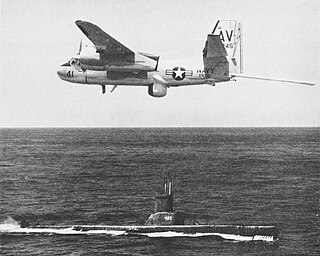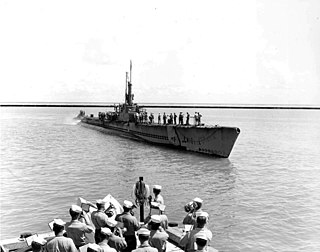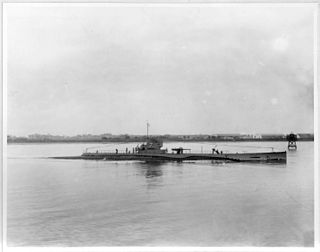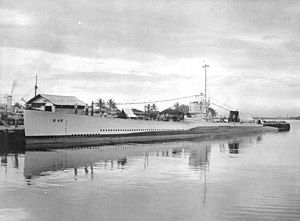USS Captor (PYc-40), briefly the seventh ship to bear the name USS Eagle (AM-132), was a Q-ship of the United States Navy.

USS Sailfish (SSR/SS/AGSS-572), the lead ship of her class of submarine, was the second ship of the United States Navy to be named for the sailfish, a large gamefish inhabiting tropical seas, related to the swordfish, but possessing scales and a large sail-like dorsal fin.

USS S-4 (SS-109) was an S-class submarine of the United States Navy. In 1927, she was sunk by being accidentally rammed by a United States Coast Guard destroyer with the loss of all hands but was raised and restored to service until stricken in 1936.

USS Bonita (SF-6/SS-165), a Barracuda-class submarine and one of the "V-boats," was the third ship of the United States Navy to be named for the bonito. Her keel was laid down by the Portsmouth Navy Yard. She was launched on 9 June 1925 as V-3 (SF-6), sponsored by Mrs. L.R. DeSteiguer, wife of Rear Admiral DeSteiguer, and commissioned on 22 May 1926, Lieutenant Commander Charles A. Lockwood, Jr. in command. Like her sisters, Bonita was designed to meet the fleet submarine requirement of 21 knots (39 km/h) surface speed for operating with contemporary battleships.
USS Trigger (SS-564), a Tang-class submarine, was the second ship of the United States Navy to be named for the triggerfish.

USS Marlin (SS-205), a Mackerel-class submarine, was the first ship of the United States Navy to be named for the marlin, a large game fish. Marlin and her near-sister Mackerel were prototype small submarines, which the Navy was exploring to replace the aging S-class submarines. References differ as to whether Marlin had a direct drive propulsion system or diesel-electric drive.

USS Sirago (SS-485), a Tench-class submarine, was named for the sirago, a small, freshwater tropical fish.

USS Requin (SS/SSR/AGSS/IXSS-481), a Tench-class submarine, was the only ship of the United States Navy to be named after the requin, French for shark. Since 1990 it has been a museum ship at the Carnegie Science Center in Pittsburgh, Pennsylvania.

USS Cabrilla (SS/AGSS-288), a Balao-class submarine, was a ship of the United States Navy named for the cabrilla, an edible fish inhabiting the Mediterranean Sea and waters off the coast of California.

USS Burrfish (SS/SSR-312) was a Balao-class submarine of the United States Navy named for the burrfish, a swellfish of the Atlantic coast. The vessel entered service in 1943 and saw action during World War II and in the postwar era. In 1961 Burrfish was loaned to the Royal Canadian Navy where she served as HMCS Grilse and was used primarily as a training boat from 1961 until 1969.

USS Sea Poacher (SS/AGSS-406), a Balao-class submarine, was a vessel of the United States Navy named for the sea poacher, a slender, mailed fish of the North Atlantic.

USS Sea Fox (SS-402), a Balao-class submarine, was a vessel of the United States Navy named for the sea fox, a large shark, also called the thresher shark, which frequents the coast of Europe and the Americas.

USS S-50 (SS-161) was a fourth-group (S-48) S-class submarine of the United States Navy.

USS S-7 (SS-112) was a second-group S-class submarine of the United States Navy. Her keel was laid down on 29 January 1918 by the Portsmouth Navy Yard. She was launched on 5 February 1920 sponsored by Mrs. Henry L. Wyman, and commissioned on 1 July 1920.
USS S-49 (SS-160) was a fourth-group (S-48) S-class submarine of the United States Navy.

USS S-6 (SS-111) was a second-group S-class submarine of the United States Navy. Her keel was laid down on 29 January 1918 by the Portsmouth Navy Yard. She was launched on 23 December 1919 sponsored by Ms. Eleanor Westcott; and commissioned on 17 May 1920.

USS S-9 (SS-114) was a second-group S-class submarine of the United States Navy. Her keel was laid down on 20 January 1919 by the Portsmouth Navy Yard. She was launched on 17 June 1920 sponsored by Mrs. James E. Palmer, and commissioned on 21 February 1921.

USS S-19 (SS-124) was a first-group S-class submarine of the United States Navy. She was in commission from 1921 to 1922 and from 1923 to 1934 and served in both the Atlantic and Pacific Oceans.

USS S-21 (SS-126) was a first-group S-class submarine of the United States Navy in commission from 1921 to 1922 and from 1923 to 1942. In 1928, she made the first gravimetric measurements ever made aboard a U.S. ship at sea. Prior to World War II, she operated in the Atlantic Ocean, Caribbean Sea, and Pacific Ocean, and after the United States entered the war, she operated off Panama. She then served in the Royal Navy as HMS P.553 from 1942 to 1944.
The Lake Torpedo Boat Company of Bridgeport, Connecticut, was an early builder of submarines for the United States Navy in the early 20th century.
















